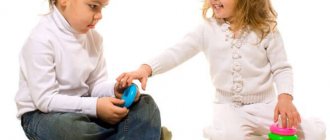Development of a child’s psyche at 4-5 years old
This age is the transition from early childhood to preschool.
The child is actively developing, exploring the world, communicating with adults and peers with pleasure, and asking many questions to parents.
He begins to realize himself in this world. His self-esteem continues to form.
The child diligently repeats the behavior for which adults praise him. It is important for him to be considered good.
At this time, mental cognitive processes develop rapidly: memory, attention, perception, thinking, imagination. They become more conscious and voluntary.
Also now the strong-willed qualities of character are being formed.
A four-year-old child begins to experience deep feelings. He learns to empathize with others. Moral concepts form the basis of his personality.
Intellectual sphere
Children 4-5 years old enjoy mastering creative activities. They really like drawing, plot modeling, and appliqué. They can depict objects quite accurately and in detail.
The development of intelligence at this age is already such that children can compose their own fairy tale, song, or come up with their own rhyme for a word.
At the age of 4, a child’s attitude towards the objective world changes. Previously, he studied the environment as it existed around him. Now the child is learning to transform objects and create something new.
A four-year-old man is capable of thinking, although sometimes making erroneous conclusions. Therefore, he cannot do without adult guidance in this matter for now.
Now he can accumulate knowledge about those objects that he has never seen (for example, about distant countries). He also acquires an attitude towards this knowledge (for example, he begins to fear predators).
For children 4-5 years old, adults are authoritative and inexhaustible sources of a wide variety of information. Therefore, children become little wonders and tirelessly ask questions about everything in the world.
Attention
Attention becomes more stable and voluntary than before.
Children can now concentrate for about 15-20 minutes. Although during an interesting game they can be immersed in the process much longer than this time.
Some guys can already remember simple instructions in their heads.
To help develop attention, you can teach your child to think out loud when completing a task.
Memory
At the age of 4-5 years, voluntary recall develops. The child can now remember the picture, although without exact details and time.
Intentional memorization is also formed. It is easier for children to retain something in memory when the task is clear and with good motivation. For example, they can easily remember the right set of toys to play with.
A four-year-old child can easily learn a poem. But for this it is necessary that he understands the meaning of the text.
Thinking
At 4-5 years old, visual and figurative thinking continues to develop. Children still need visibility, but they are already successfully playing with substitute toys (for example, pebbles instead of cars). They can also now use schematic images to solve a problem (for example, build a pattern according to a diagram or go through a maze).
A four-year-old child can anticipate an event or phenomenon. That is, he can tell what will happen to objects from their interaction with each other. For example, if you push a cup onto the floor, it will break.
Children 4-5 years old can find differences and similarities between objects. They can also assemble a picture from 4 parts without looking at the sample.
Perception
The child actively improves his perception.
He learns to measure, compare objects by superimposing and applying them to each other.
Knowledge about
- flowers,
- forms,
- geometric shapes,
- size,
- time (time of day, time of year),
- space (up, down, far, close),
- taste (salty, sour, bitter, sweet),
- smell,
- surface quality (smooth, fluffy, rough, etc.),
- sound
Imagination
During this period, imagination develops significantly.
A child can come up with something of his own free will. His images are so vivid and realistic to him that he believes in their existence.
At 4-5 years old, children may develop fears. This happens due to great impressionability and rich imagination. This is a normal feature of mental development.
Speech sphere
Speech abilities also develop.
Diction and sound pronunciation improves.
The child actively uses speech; his vocabulary is now about 2000 words. He knows how to fully communicate and express his thoughts. He can characterize an object, describe emotions, retell a short text and answer questions about it.
A four-year-old child uses prepositions correctly and learns to construct complex sentences. He also tries to highlight significant phrases with intonation.
Emotional-volitional sphere
During this period, the emotional sphere develops significantly.
The child's feelings become deeper and more stable. For example, the joy of communication turns into a feeling of sympathy and affection. They, in turn, form moral feelings - kindness, a sense of friendship, etc.
Children learn to empathize with other people.
At the same time, they still strive for independence, just as before. But failures can now greatly upset them. If this happens often, children may develop self-doubt and fear of failure.
Play activity
Themed games
A four-year-old child strives to communicate and play with his peers. At the same time, he is no longer interested in just “playing nearby.” Now he needs a full-fledged play partner.
During games, children learn the subtleties of communication. They quarrel, make peace, help. are friends.
The first thematic role-playing games arise in gaming activities. Moreover, children are now interested in communicating with peers of the same sex.
For example. girls like to play shop or mother-daughter together, and boys team up to play sailors or soldiers.
Games and toys for children 4-5 years old
As at any other age, toys should be appropriate for the child’s age. This will allow him to maximize his abilities and skills through the game.
Here are the toys a 4-5 year old child needs:
- for the development of fine motor skills - Legos, construction sets, puzzles, lacing, mosaics, etc.;
- to develop gross motor skills - outdoor games with large toys (dolls, skittles, cars);
- sports toys - ball, jump rope;
- children's transport - bicycle, scooter, balance bike;
- for role-playing games - sets of a doctor, a salesman, a hairdresser, a suitcase with tools, etc.;
- for creativity - pencils, paints, appliques, plasticine, children's scissors, easel.
Reading fairy tales and poems is also very useful. After reading, it is worth discussing the actions of the characters and finding out the child’s opinion about them. An excellent game option is to dramatize fairy tales using dolls or figurines.
At this age, computer games are still not recommended.
Communication sphere
For a four-year-old child, communication with peers is very important. It is no longer enough for him to play with his toys alone or in the company of his parents.
The child wants to be recognized among his peers.
During this period, the first friends appear. And in the group of children the first leaders and competition emerge.
Communication with peers is associated with play and other joint activities.
And when talking with adults, children learn to talk about things that do not relate to a specific situation. They strive to ask as many questions as possible and get answers to everything.
Raising a 4 year old child
Raising a child is quite a complex matter, because it is an individual person with his own desires, emotions and his own opinion. The way a child is raised as a child affects every aspect of his or her later life. That is why this issue should be approached very carefully.
If in early childhood a child’s life is controlled mainly by instincts and emotions, then by the age of 3-4 years his behavior becomes more conscious. To choose the right direction in raising a 4-year-old child, let's look at the key points in the development of children at this age.
Features of raising children 4 years old
- By the age of 4-5 years, the child’s emphasis gradually shifts from physical activity to mental activity. He is no longer interested in running and jumping for hours on end, but more often wants to engage in calmer games. Children are attracted to all kinds of creativity: drawing, modeling, making various crafts. Encourage this behavior, especially if your child is not very persistent, and be sure to take part in his games and activities.
- As for physical development, 4 years is the time to enroll your child in a sports section (gymnastics, swimming). Don’t forget about daily walks - this strengthens the immune system, and playing in the fresh air develops gross motor skills.
- If your child already knows the alphabet, then you can already start learning to read it. You can also introduce him to the basics of mathematics. It is better to conduct classes in a playful way. At this age, the baby can already master counting to 10, the concepts of addition and subtraction using toys as an example.
- At the age of 4, curiosity awakens in all children. The endless “whys” can unsettle any parent. But this, of course, should not be allowed. The child’s questions must be answered directly, without unnecessary details. If you yourself do not have the necessary information, then tell your child about it and promise to find the answer to his tricky question in the near future.
- Most likely, at this age your son or daughter is already attending kindergarten. If a child has problems adapting to a group, you must help him overcome them. First, you need to determine the reason for this (embarrassment, shyness, jealousy, etc.), and then teach the baby (preferably with specific examples) to communicate correctly with children, share toys, or stand up for themselves if necessary. If the problem becomes global, it is better to seek help from a child psychologist.
- In the process of growing up, the child’s psyche undergoes certain changes. The baby begins to experience new feelings: resentment, irritation, sadness, shame. He doesn’t yet know how to cope with them, and may “behave badly” or “disobey.” Support your baby, tell him that it is normal to experience emotions, that you yourself sometimes feel the same. Explain to your child that it is much more convenient to express your feelings with words rather than with bad behavior.
- It is necessary to praise, scold, and punish children. The lack of praise is felt very acutely by children, and without punishment, education is more difficult. But keep in mind that you need to punish strictly to the point, and comments should be made so that the child understands what they want from him (for example, say “Speak more quietly” instead of “How much can you scream!”). You need to praise your child not for what he already knows how to do, but for new achievements or great effort in some matter. In addition, don't forget to tell your four-year-old how much you love him, even if his behavior leaves much to be desired.
Differences in raising a girl and a boy at 4 years old
As practice shows, raising a 4-year-old girl is easier than raising a boy. This is due to the fact that they are most often calmer and obedient, and by this age purely feminine traits begin to appear in them. Girls love to play “mother-daughter”, “doctor”, “shop” and other role-playing games, often twirling in front of the mirror and trying on outfits. By encouraging this behavior, maintain your daughter’s confidence that she is the most beautiful - this will help her in the future have adequate self-esteem and eventually become feminine. Also, girls from an early age should be instilled with a love of cleanliness, neatness, and punctuality.
As for boys, they are naturally more active and often even aggressive. 4 years is the age at which a small representative of the stronger sex should already know that girls cannot be offended, and understand why. If not, it’s time to explain it to him clearly. Dad must also devote time to raising a boy; for a four-year-old child this is already of great importance. In addition, try to set as few restrictions as possible for your child: an active boy will still find a way to overcome them. The more you engage in joint activities and games with your child, the more capable, inquisitive and smart he will grow up.
Difficulties of age
4-5 years is a period of relative calm after a difficult crisis of 3 years. The child again becomes obedient and flexible.
But even at this age there are difficulties.
A child's rich imagination can give rise to fears - for example, monsters or evil fairy tale characters. Adults do not need to focus attention on them. And even more so, you cannot use a child’s fears for educational purposes by intimidating him.
Also, a four-year-old child is very vulnerable and sensitive. Therefore, it is important for parents to watch their words. After all, an accidentally thrown careless phrase addressed to a child can traumatize him for a long time.
It is very important for children now to hear praise from an adult in order to understand that they are good. If adults do not attach importance to some act or action of the child, he may be seriously offended.
At 4-5 years old, bad habits and character flaws can easily take root. Therefore, it is important to correct them in a timely manner.
Neuropsychic development at 5 years old
A 5-year-old child is developing very well psychomotorally. After all, neuropsychic development is the most important thing at this age. During walks, the baby is resilient, examines the world around him with interest and learns everything new with excitement. At this age, the baby’s fine motor skills are strengthened. The baby begins to show interest in visual and creative activities. The little ones love to draw, cut and glue things, build magic castles and decorate their room with handmade items.
Speech begins to develop very actively. Moreover, the child can perfectly form his own thoughts. That is, he can retell the fairy tale that you read to him at night. Can construct sentences well and ask you for things. In addition, children at this age actively share their impressions that they saw in kindergarten. The vocabulary increases and the child can communicate well what he thinks and wants to express.
The child uses speech to communicate with his peers. He begins to very actively train his speech abilities. Very often, at the age of five, a child asks simply a huge number of questions. In addition, he gains the ability to reason and retell previously occurring events. Sometimes children write poems and sing songs. All this develops their speech, which is not unimportant in this difficult period of a child’s life.
The kid has already learned to solve quite complex problems. He can distinguish objects based on certain characteristics at a fairly high level than before. It should be noted that the logic of a 5-year-old child is very unique and you need to get used to it. At 5 years old, a child can already learn a short rhyme or song. That is, he develops conscious memorization of certain things. But, there are some nuances here. It is necessary to develop semantic memory in a child. That is, the baby must know what he is being asked to learn, that is, be aware of it. He must understand what is required of him and why it is needed.
Favorable development: tips for parents
A parent for a four-year-old child is a certain standard of behavior. Therefore, adults themselves need to follow the requirements that they place on the child.
The child believes everything the parent tells him. Therefore, any new information for him must be true.
It’s great if adults are willing to answer the child’s questions, ask for his opinion, and also encourage him to reason.
It is important for adults to talk to the child about their and his feelings, to explain the motives and consequences of actions.
You should not tell a four-year-old person scary stories, talk about serious illnesses and death. This may overwhelm him and frighten him.
It is important to discuss his fears with the child and “live” them with him.
Too much punishment or disapproval from adults will cause the child to stop taking the initiative. He may also have a fear of punishment and a constant feeling of guilt.
Now you need to praise and encourage the child for his good deeds.
It is necessary to provide children with opportunities for creativity and self-expression, as well as be interested in their results.
We also need to give them the opportunity to often be outside, move actively and play with other children.
At the age of 4-5, it is important to teach children moral qualities: responsibility, responsiveness, love for work, etc. Through your example and in joint activities, you need to instill hard work, mutual assistance, etc.
Children also need to be taught how to communicate with other children - to give in, to share, to defend their interests.
We need to tell them about the rules of behavior in various situations. For example, on the site, at the clinic as a guest, etc.
The age of 4-5 years is a rather calm, but important period in the development of a child’s psyche. During this period, self-esteem, moral qualities, deep feelings and attachments are actively formed. In addition, cognitive processes and ideas about the world around them are developing rapidly. It is important for parents to set a positive example for their child, provide him with space for self-expression and communication with peers, and also be attentive to his feelings.
If you liked the article, please share a link to it
Features of the psychophysical development of children of the 5th year of life article (middle group) on the topic
Features of psychophysical development of children of the 5th year of life
This is the age of further development of abilities. Having done something interesting, a child is less distracted from what he is doing than before. His games become longer and more complex. The child learns to act consistently, obeys the rules: not only those that we dictate to him, but also those that he develops for himself.
He already remembers better and tries to reason. These arguments are still very naive and often make us smile. The child strives to understand the interconnection of events, to guess the reasons for what is happening around him.
He is already able to evaluate the properties of things, comparing them with each other, noticing the similarities and differences between them. By the age of 5, children have an increased need to communicate, especially with peers, and to understand their position among them. Better oriented in human relationships: able to notice the emotional state of a close adult, show attention and sympathy.
Pride in one's own achievements and the desire to demonstrate one's skills in front of peers are especially important for a child in middle age, as he develops a need for respect.
In the 5th year, ideas are formed about how to behave, so they turn to their peers: “we must share”, “you cannot offend others.” Freedom of behavior is expressed in the desire to perform independent actions, choose this or that activity (game), children, with whom to play.
And now I want to dwell on the most informative and complex indicator of development - mental development. In the broad sense of the word, mental development refers to the development of basic cognitive processes: perception, memory, attention. What changes are taking place?
Visual arts are undergoing significant development. The drawing becomes substantive and detailed. The graphic image of a person is characterized by the presence of a torso, eyes, mouth, nose, hair, and sometimes clothing and its details. The technical side of visual arts is being improved. Children can draw basic shapes, cut out with scissors, stick on images
Design becomes more complicated. Buildings can include 5-6 parts. Design skills according to one’s own design are developed, as well as planning a sequence of actions.
Motor sphere of the child. Characterized by positive changes in fine and gross motor skills. Develops dexterity and coordination of movements. Children at this age are better than younger preschoolers,
maintain balance and step over small obstacles. Ball games become more difficult.
By the end of middle preschool age, perception becomes more developed. Children are able to name the shape that this or that object resembles. They can isolate simple forms from complex objects and recreate complex objects from simple forms. Children are able to organize groups of objects according to sensory characteristics - size, color; select parameters such as height, length and width. Orientation in space is improved. Memory capacity increases. Children remember 7-8 names of objects. Voluntary memorization begins to take shape: children are able to accept a memorization task, remember instructions from adults, can learn a short poem, etc.
In middle preschool age, the pronunciation of sounds and diction improves. Speech becomes the subject of children's activity. They successfully imitate the voices of animals and intonationally highlight the speech of certain characters. The rhythmic structure of speech and rhymes are of interest. The grammatical aspect of speech develops. Children engage in word creation based on grammatical rules. The speech of children when interacting with each other is situational in nature, and when communicating with an adult it becomes extra-situational.
Perception
A child at this age not only has a good understanding of the primary colors of the spectrum, but also has an idea of shades.
Can match 7-10 objects of the same shape by size.
Can name the differences between two figures of different shapes.
Can divide a complex spectral figure into several simple ones.
Thinking
A child can make a simple building (from cubes) according to the proposed scheme.
Recognize objects in schematic images. The child can find a way out of a simple maze (2-3 partitions). Classifies, generalizes simple words, can highlight the main features.
Imagination
The child can complete the initial image and add details to it.
Can independently compose a short fairy tale or story on a given topic.
Attention
The child can engage in activities that are attractive to him for 15-20 minutes.
The child can act in accordance with the rules: select the necessary pictures, shade the necessary figures.
By the age of 5, you can offer the following game for attention: rows of squares, circles and triangles are depicted in random order on a sheet of paper. Offer to paint over one type of geometric shape, for example a triangle.
Memory
A child can remember 5 names of objects at the request of an adult. The child remembers the adult’s instructions (2-3 consecutive actions).
What does it take for a child to grow up inquisitive, smart, and quick-witted? So that all his possibilities can be realized, his abilities revealed?
Our advice: try to listen to the child, understand and take into account the characteristics of this age, and evaluate his own individual capabilities.










